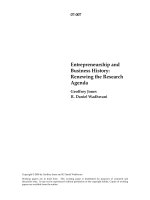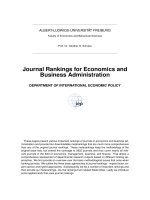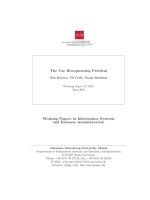Economic and business forecasting
Bạn đang xem bản rút gọn của tài liệu. Xem và tải ngay bản đầy đủ của tài liệu tại đây (17.3 MB, 403 trang )
Cover image: © Ekspansio/iStockphoto, elly99/iStockphoto
Cover design: Andrew Liefer
Copyright © 2014 by John Silvia, Azhar Iqbal, Kaylyn Swankoski, Sarah Watt, and Sam
Bullard. All rights reserved.
Published by John Wiley & Sons, Inc., Hoboken, New Jersey.
Published simultaneously in Canada.
No part of this publication may be reproduced, stored in a retrieval system, or transmitted
in any form or by any means, electronic, mechanical, photocopying, recording, scanning,
or otherwise, except as permitted under Section 107 or 108 of the 1976 United States
Copyright Act, without either the prior written permission of the Publisher, or
authorization through payment of the appropriate per-copy fee to the Copyright
Clearance Center, Inc., 222 Rosewood Drive, Danvers, MA 01923, (978) 750-8400, fax
(978) 646-8600, or on the Web at www.copyright.com. Requests to the Publisher for
permission should be addressed to the Permissions Department, John Wiley & Sons, Inc.,
111 River Street, Hoboken, NJ 07030, (201) 748-6011, fax (201) 748-6008, or online at
/>Limit of Liability/Disclaimer of Warranty: While the publisher and author have used their
best efforts in preparing this book, they make no representations or warranties with
respect to the accuracy or completeness of the contents of this book and specifically
disclaim any implied warranties of merchantability or fitness for a particular purpose. No
warranty may be created or extended by sales representatives or written sales materials.
The advice and strategies contained herein may not be suitable for your situation. You
should consult with a professional where appropriate. Neither the publisher nor author
shall be liable for any loss of profit or any other commercial damages, including but not
limited to special, incidental, consequential, or other damages.
For general information on our other products and services or for technical support,
please contact our Customer Care Department within the United States at (800) 7622974, outside the United States at (317) 572-3993 or fax (317) 572-4002.
Wiley publishes in a variety of print and electronic formats and by print-on-demand.
Some material included with standard print versions of this book may not be included in
e-books or in print-on-demand. If this book refers to media such as a CD or DVD that is
not included in the version you purchased, you may download this material at
. For more information about Wiley products, visit
www.wiley.com.
Library of Congress Cataloging-in-Publication Data:
Silvia, John.
Economic and business forecasting : analyzing and interpreting econometric results /
John Silvia, Azhar Iqbal, Kaylyn Swankoski, Sarah Watt, Sam Bullard.
pages cm. (Wiley & SAS business series)
ISBN 978-1-118-49709-8 (cloth); ISBN 978-1-118-56980-1 (ebk);
ISBN 978-1-118-56954-2 (ebk)
1. Economic forecasting. 2. Business forecasting. 3. Decision-making. 4.
Econometrics. I. Title.
HB3730.S484 2014
330.01'5195—dc23
2013039764
Printed in the United States of America
10 9 8 7 6 5 4 3 2 1
To Tiffani Kaliko, Penny and Sherman
Shahkora and Mohammad Iqbal, Nargis, Saeeda, Shahid and
Noreen
And to the family and friends who remain our wellsprings of
inspiration
If a man will begin with certainties,
he shall end in doubts,
but if he will content to begin with doubts,
he shall end in certainties.
—Francis Bacon, The Advancement of Learning1605
Contents
Preface
Acknowledgments
Chapter 1 Creating Harmony Out of Noisy Data
Effective Decision Making: Characterize the Data
Chapter 2 First, Understand the Data
Growth: How Is the Economy Doing Overall?
Personal Consumption
Gross Private Domestic Investment
Government Purchases
Net Exports of Goods and Services
Real Final Sales and Gross Domestic Purchases
The Labor Market: Always a Core Issue
Establishment Survey
Data Revision: A Special Consideration
The Household Survey
Marrying the Labor Market Indicators Together
Jobless Claims
Inflation
Consumer Price Index: A Society's Inflation Benchmark
Producer Price Index
Personal Consumption Expenditure Deflator: The Inflation Benchmark
for Monetary Policy
Interest Rates: Price of Credit
The Dollar and Exchange Rates: The United States in a Global Economy
Corporate Profits
Summary
Chapter 3 Financial Ratios
Profitability Ratios
Summary
Chapter 4 Characterizing a Time Series
Why Characterize a Time Series?
How to Characterize a Time Series
Application: Judging Economic Volatility
Summary
Chapter 5 Characterizing a Relationship between Time Series
Important Test Statistics in Identifying Statistically Significant
Relationships
Simple Econometric Techniques to Determine a Statistical Relationship
Advanced Econometric Techniques to Determine a Statistical
Relationship
Summary
Additional Reading
Chapter 6 Characterizing a Time Series Using SAS Software
Tips for SAS Users
The DATA Step
The PROC Step
Summary
Chapter 7 Testing for a Unit Root and Structural Break Using SAS
Software
Testing a Unit Root in a Time Series: A Case Study of the U.S. CPI
Identifying a Structural Change in a Time Series
The Application of the HP Filter
Application: Benchmarking the Housing Bust, Bear Stearns, and Lehman
Brothers
Summary
Chapter 8 Characterizing a Relationship Using SAS
Useful Tips for an Applied Time Series Analysis
Converting a Dataset from One Frequency to Another
Application: Did the Great Recession Alter Credit Benchmarks?
Summary
Chapter 9 The 10 Commandments of Applied Time Series Forecasting for
Business and Economics
Commandment 1: Know What You Are Forecasting
Commandment 2: Understand the Purpose of Forecasting
Commandment 3: Acknowledge the Cost of the Forecast Error
Commandment 4: Rationalize the Forecast Horizon
Commandment 5: Understand the Choice of Variables
Commandment 6: Rationalize the Forecasting Model Used
Commandment 7: Know How to Present the Results
Commandment 8: Know How to Decipher the Forecast Results
Commandment 9: Understand the Importance of Recursive Methods
Commandment 10: Understand Forecasting Models Evolve over Time
Summary
Chapter 10 A Single-Equation Approach to Model-Based Forecasting
The Unconditional (Atheoretical) Approach
The Conditional (Theoretical) Approach
Recession Forecast Using a Probit Model
Summary
Chapter 11 A Multiple-Equations Approach to Model-Based Forecasting
The Importance of the Real-Time Short-Term Forecasting
The Individual Forecast versus Consensus Forecast: Is There an
Advantage?
The Econometrics of Real-Time Short-Term Forecasting: The BVAR
Approach
Forecasting in Real Time: Issues Related to the Data and the Model
Selection
Case Study: WFC versus Bloomberg
Summary
Appendix 11A: List of Variables
Chapter 12 A Multiple-Equations Approach to Long-Term Forecasting
The Unconditional Long-Term Forecasting: The BVAR Model
The BVAR Model with Housing Starts
The Model without Oil Price Shock
The Model with Oil Price Shock
Summary
Chapter 13 The Risks of Model-Based Forecasting: Modeling, Assessing,
and Remodeling
Risks to Short-Term Forecasting: There Is No Magic Bullet
Risks of Long-Term Forecasting: Black Swan versus a Group of Black
Swans
Model-Based Forecasting and the Great Recession/Financial Crisis:
Worst-Case Scenario versus Panic
Summary
Chapter 14 Putting the Analysis to Work in the Twenty-First-Century
Economy
Benchmarking Economic Growth
Industrial Production: Another Case of Stationary Behavior
Employment: Jobs in the Twenty-First Century
Inflation
Interest Rates
Imbalances between Bond Yields and Equity Earnings
A Note of Caution on Patterns of Interest Rates
Business Credit: Patterns Reminiscent of Cyclical Recovery
Profits
Financial Market Volatility: Assessing Risk
Dollar
Economic Policy: Impact of Fiscal Policy and the Evolution of the U.S.
Economy
The Long-Term Deficit Bias and Its Economic Implications
Summary
Appendix: Useful References for SAS Users
About the Authors
Index
Preface
Due to the Great Recession (2007–2009) and the accompanying financial
crisis, the premium on effective economic analysis, especially the
identification of time series and then accurate forecasting of economic and
financial variables, has significantly increased. Our approach provides a
comprehensive yet practical process to quantify and accurately forecast key
economic and financial variables. Therefore, the timing of this book is
appropriate in a post-2008 world, where the behavior of traditional
economic relationships must be reexamined since many appear out of
character with the past. The value proposition is clear: The framework and
techniques advanced here are the techniques we use as practitioners. These
techniques will help decision makers identify and characterize the patterns
of behavior in key economic series to better forecast these essential
economic series and their relationships to other economic series.
This book is for the broad audience of practitioners as well as
undergraduate and graduate students with an applied economics focus. This
book introduces statistical techniques that can help practitioners
characterize the behavior of economic relationships. Chapters 1 to 3
provide a review of basic economic and financial fundamentals that
decision makers in both the private and public sectors need to know. Our
belief is that before an analyst attempts any statistical analysis, there should
be a clear understanding of the data under study. Chapter 4 provides the
tools that an analyst will employ to effectively characterize an economic
series. One relationship of interest is the ability of leading indicators to
predict the pattern of the business cycle, particularly the onset of a
recession. Another way to characterize economic relationships is to reflect
on the current trend of any economic series of interest relative to the
average behavior over prior cycles. In a third approach, we may be
interested in identifying the possibility of a structural change in an
economic time series to test if the past history of a variable would be
different over time.
Different economic and financial variables exhibit differential behavior
over the business cycle and over time. In this book we focus on a select set
of major economic and financial variables, such as economic growth, final
sales, employment, inflation, interest rates, corporate profits, financial
ratios, and the exchange value of the dollar.
Our analysis then extends the text into the relationships between different
time series. This analysis begins with Chapter 5, and then in Chapters 6 and
7 we take a look at the SAS® software employed in our analysis. We also
examine these variables' patterns over the business cycle, with an emphasis
on their recent history, using econometric techniques and the statistical
software SAS as a template for the reader to apply to variables of interest.
These variables form the core of an effective decision-making process in
both the private and public sectors. Chapter 8 provides techniques that an
analyst can employ and contains numerous examples of our techniques in
action.
Our approach has several advantages. First, effective decision making
involves an analysis of the behavior of select economic and financial
variables. By choosing a small set of economic factors, we provide a
template for decision making that can be easily applicable to a broader set
of variables for future study in many economic fields. Our focus is on the
importance of a limited, but central, set of select economic and financial
variables that provide special insights into economic performance, along
with the empirical evidence of their vital role to the economy and financial
markets.
Second, using a small set of simple data descriptors and econometric
techniques to characterize and describe the behavior of economic variables
provides value in a number of contexts. We can examine the behavior of
any particular economic series in numerous ways so that the analysis is less
subject to personal beliefs and biases. This helps overcome the
confirmation bias of many decision makers who search for the results they
want to see from any analysis. Many analysts may search for the
comfortable, familiar historical statistical relationships in a post-2008 era
when, in fact, many of those relationships have vanished.
Third, our detailed discussion about SAS and its applications creates a
valuable starting point for researchers. We provide a practical forecasting
framework for important everyday applications. Finally, our work
discusses SAS results and identifies econometric issues and solutions that
are of interest to addressing a number of economic and business issues. One
outgrowth of our experience with many of these issues is reviewed in
Chapter 9, where we focus on our 10 commandments of applied time series
forecasting. Chapters 10 and 11 build on these commandments with a focus
on single equations in Chapter 10 and multiple equations in Chapter 11.
The net result is the application of econometrics in a way that contributes
to effective decision making in both the private and public sectors. In
Chapter 12 we focus on model-based forecasting applied to make long-term
forecasts for the next five to 10 years, which reflects the reality of
determining the real sustainability of projects and their profitability
overtime. Chapter 13 then highlights the risks and challenges of such
forecasting. Finally in Chapter 14 we illustrate some of the lessons we have
learned in recent years as we identify and understand the changes that are
ongoing in the twenty-first-century economy. As an additional resource,
there is a test bank to accompany this text.
This book is dedicated first to young professional economists and
aspiring students who wish to provide a thoughtful statistical basis for
better decision making in their careers, whether it is in the public or the
private sector. This book is also aimed to serve professional analysts who
wish to provide statistical support for effective decision making. This work
reflects the years of experience of the authors whose work contains a focus
on simple yet practical techniques needed for efficient decision making
without extensive theoretical and mathematical refinements that are
ancillary to effective decision making. That we leave for authors with the
luxury of time and tenure. The techniques in the text are being used in our
work every day. They have brought us numerous forecasting awards and
published papers that reflect the practical undertakings required of young
professionals who wish to add value to the decision-making process in
their organizations.
Acknowledgments
We would like to thank all the people who have supported us through the
writing and publication of this book. Special thanks to Larry Rothstein and
Zachary Griffiths, for without their help this book would not have been
possible. We also wish to express our gratitude for the many people at
Wells Fargo who have supported this project, including Diane SchumakerKrieg and John Shrewsberry, as well as the technical support staff at Wells
Fargo. Thank you Robert Crow, editor of Business Economics, and the
referees of that journal as well as the referees of articles that have
appeared in other journals; you have improved the quality of our research
over the years. We are grateful for the instructors and students who have
come into our lives and taught and inspired us (Nuzhat Ahmad, M. S. Butt,
Kajal Lahiri, Asad Zaman, Adil Siddique, Ambreen Fatima, Hasan N.
Saleem, Jon Schuller, and Anika Khan).
CHAPTER
1
Creating Harmony Out of Noisy
Data
B
y the spring of 2012, the economic performance of the United States
was operating at a much different pace from what many analysts had
expected. Decision makers in both private and public sectors faced a set of
mixed and unclear economic and financial indicators that offered a
confused picture of the state of the economic recovery, the pace of that
recovery, and the character of the structural challenges facing the economy.
Three major trends characterized the confusion. First, top-line economic
growth had been unusually low and uneven relative to past economic
recoveries since World War II. During the recovery, the economy
accelerated after an initial stimulus but then lost momentum as the stimulus
generated no follow-on growth. Decision makers had the difficult challenge
of identifying what the true trend in the economy was and what the cycle
around that trend was. Had trend economic growth downshifted in the
United States?
Second, job growth had become the number one political issue. But the
lack of job growth appeared out of line with traditional economic models
on a cyclical basis. Further, weak job growth intimated a sharp structural
break in both private and public sector decision makers' preconceived
understanding of the relationship between employment and population
growth. Had there been a structural break between employment and
population growth, and/or between employment and output growth? Why
have exceptionally low mortgage interest rates not spurred a pickup in
housing, as in prior recoveries? Had this relationship experienced a
structural break as well?
Third, corporate profits, business equipment spending, and industrial
production had improved in this cycle in a way reminiscent of prior
recoveries despite the overall perception that the economic recovery had
been subpar. How can we identify economic series that appear to be
behaving in typical cyclical fashion compared to those that are not?
In this book, we test whether certain series, such as output, employment,
profits, and interest rates, exhibit a steady pace of growth over time, or if
that pace has drifted. In statistical terms, is the series stationary or not? If
not, then oft-used statistical tools cannot be employed to evaluate the
behavior of an economic series without introducing statistical bias.
To address these issues effectively, we examine many economic and
business series and pursue alternative statistical approaches to make
effective decisions based on the application of simple economic and
statistical methods. Our work here is in contrast to two common
approaches: econometric-only approaches or economic theory-only
approaches. Our work returns to an earlier tradition of applied research
rather than mathematical elegance, which is an alternative to econometrics
that uses all technique with little to no real-world application or all-theory
approaches with no technique and only hypotheses about the real world.
EFFECTIVE DECISION MAKING: CHARACTERIZE THE
DATA
The first task for many analysts is to characterize the behavior of a
particular time series. For example, is there a cyclical component to the
data? Many economic data series show some cyclicality, but, alternatively,
some are driven more by secular changes in our economy—for example,
the labor force participation rate trended steadily higher between the early
1960s and late 1990s as women joined the workforce. Yet often a time
series, such as employment, is influenced by both cyclical and secular
factors, where the cyclical element may change the pace but not derail
longer-term secular shifts in the economy.
If a time series does display a cyclical component, how does it behave as
we move through the business cycle? Does the data in the time series
decline when the economy is in a recession, or is it countercyclical and
increase during a recession, such as the saving rate for households? How
distinguishable are turning points in the series? If the series is volatile on a
period-to-period basis, a large move in one direction or another may not be
enough to signify a turning point, but instead care must be taken with a few
recent data points in order to smooth out any volatility and distinguish the
true trend. Moreover, do turning points in the time series lead or lag those
of other series? Is the time series linear or nonlinear over the period of
study?
Part IA: Identifying Trend in a Time Series: GDP and
Public Deficits
Throughout the recovery from the Great Recession of 2007 to 2009, the
pace of economic growth has been below par, and public sector deficits
have persisted. This has led to a greater problem of public debt than many
policy makers anticipated when the recovery began. Today, perceptions of
the effectiveness of fiscal policy actions and the competitiveness of the
U.S. economy have been brought into question. Both are critically
dependent on the estimates of the underlying trend in essential economic
variables like growth, inflation, interest rates, corporate profits, and the
dollar exchange rate as well as other financial variables. For example, one
key issue since the recession of 2007 to 2009 has been to identify the trend
pace of economic growth, which, in turn, reflects the influence of
underlying economic forces, such as productivity growth and labor force
participation. Identifying the trend of these series helps to characterize the
pattern of sustainable federal, state, and local revenues that will make for
better budgeting in government and help guide policy makers over time.
The question is: What is the trend pace of economic growth, and has that
pace downshifted in the United States over recent years? This issue is
critical at both federal and state levels of government as well as for the
strategic vision of private sector firms when they estimate their top-line
revenue growth. Trend growth in the United States is a primary driver of tax
revenues and thereby influences the outlook for budget deficits—a key
focus of policy today. The ability of federal and state policy makers to
balance their budgets depends critically on the pace of economic growth.
Trend growth reflects the underlying influence of productivity and labor
force participation rates at the national level.
But unfortunately, many decision makers suffer from an anchoring bias. 1
They base decisions on estimates anchored on historical growth rates
without consideration that the model of economic growth they are using may
have been altered. Nor do they consider that the potential growth of the
economy, and therefore federal revenues, has downshifted compared to past
estimates.
It is also important to distinguish whether the pace of economic growth,
for example, can be described as a linear trend or as a nonlinear trend. If it
is a linear trend, then the average pace of growth would provide a useful
benchmark for anticipating revenues over time and thereby improve budget
forecasts. If the trend is nonlinear, however, then estimating the growth of
public revenues becomes more difficult, as will forecasting top-line
revenue for private sector businesses. It is also important to know whether
the average rate of economic growth has changed over time and whether its
volatility has altered as well. Interpreting econometric issues of trend and
volatility in a useful context is vital to practical decision making. For
example, if the average rate of economic growth has downshifted, private
firms are likely to become more cautious in hiring and equipment spending
while also increasing oversight on inventories. Similarly, rising volatility
for any series suggests a heightened sense of risk in using that series, which
will also alter the behavior of decision makers toward an emphasis on
avoiding risk.
FIGURE 1.1 Real GDP (Year-over-Year Percentage Change)
Source: U.S. Bureau of Economic Analysis
Therefore, the first step in an econometric analysis is to identify the
character of a trend in a time series—that is, whether a time series follows
a linear or a nonlinear trend. A linear trend indicates a constant growth rate
in a series and a nonlinear trend represents a variable growth rate. For
trend selection, we will employ different types of methods, including tvalue, R-squared, Akaike Information Criteria (AIC), and Schwarz
Information Criteria (SIC).2 A complete estimation process to identify the
time in a time series is discussed in Chapter 6, and the U.S. unemployment
rate is used as a case study.
Here we focus on the real gross domestic product (GDP) growth rate and
determine the type of trend. The results indicate that the real GDP growth
rate follows a nonlinear—more likely inverted U-shaped—time trend since
1980. The nonlinear trend implies that the average growth rate of real GDP
is not constant over time, and it increases at a faster rate for some periods
than others (see Figure 1.1). Since the average growth rate is not constant
over time, it is therefore not an easy task to forecast the future real GDP
trend.
Another way to characterize the rate of GDP growth is to calculate the
mean, standard deviation, and stability ratio for different business cycles.
Using a trough-to-trough definition of a business cycle, there were three
business cycles between 1982 and 2009. As shown in Table 1.1, the
average growth rate for the entire sample is 2.98 percent and the standard
deviation is 2.1 percent, which is smaller than the mean. The stability ratio
—the standard deviation relative to the mean—is 70.47 percent. However,
when we break the series down into periods of individual business cycles,
the stability ratio changes. For instance, the highest average growth rate
during 1982 to 2009 is attached to the 1982 to 1991 business cycle; after
that, the average growth rate declined in each subsequent business cycle.
The most volatile business cycle is the 2001 to 2009 cycle, as this period
experienced the smallest average growth rate along with the highest
standard deviation.
TABLE 1.1 Real Gross Domestic Product (Year-over-Year Percentage Change)
Both trend and business cycle analysis reveal that the average real GDP
growth varies over time, with some periods having a higher average growth
rate than others, as shown in Table 1.1. Moreover, the average growth rate
has a decreasing trend over time, while swings in GDP growth—evidenced
by the stability ratio—have gotten larger. Note the growth rate for the 2001
to 2009 period is far below the pace of 1982 to 1991 and 1991 to 2001
periods. Meanwhile, the stability ratio for the 2001 to 2009 period exceeds
that of the two earlier periods.
Part IB: Identifying the Cycle for a Time Series
In recent years, decision makers have been challenged to identify the
changes in the stage of the business cycle—recession, recovery, expansion,
slowdown—in the U.S. economy along the lines of the stylized economic
cycle pictured in Figure 1.2 using industrial production. This identification
is essential for business management in terms of planning production
schedules, adjusting inventories and ordering inputs for the production
process. In government, identifying the stage of the economic cycle will
allow for better preparation for the cyclical rhythms of revenues and
spending flows. Here again we see the importance of simple data
description to improve decision making.
To identify a cycle in an economic or financial time series, we recognize
first that many, but not all, macroeconomic time series follow a predictable
pattern over the business cycle and, as such, can be characterized by certain
statistical properties. In this sense, econometrics can provide a solution to
identifying changes in a series over the economic cycle and can allow
decision makers to anticipate those changes and alter their business plans
accordingly. We employ a number of techniques to identify and characterize
a cycle, such as the mean, variance, autocorrelation, and partial
autocorrelation. A complete econometric analysis to identify the cyclical
elements in a time series is presented in Chapter 6. Other important
macroeconomic variables with cyclical properties are GDP growth, the
consumer price index (see Figure 1.3), corporate profits (see Figure 1.4),
productivity (see Figure 1.5), employment (see Figure 1.6), federal budget
deficit/surplus (see Figure 1.7), the yield curve (10 year/2 year, see Figure
1.8), and the credit spread (AA/5 year, see Figure 1.9).
FIGURE 1.2 Total Industrial Production Growth (Output Growth by Volume, Not Revenue)
Source: Federal Reserve Board
In the following section we characterize nonfarm payrolls growth using
autocorrelations and partial autocorrelations functions.3 A simple plot of
the payrolls growth (see Figure 1.10) suggests that it may not contain an
explicit (linear) time trend, but it does contain a strong cyclical element.
During an economic expansion, the rate of employment growth is greater
than zero, and during a recession, the rate of employment growth turns
negative. To confirm the cyclical behavior of payrolls growth, we plot
autocorrelations and partial autocorrelations along with two-standard
deviation error bands (standard errors). A good rule of thumb to determine
whether a series contains a cyclical element is to check whether: (1)
autocorrelations are large relative to their standard errors, (2)
autocorrelations have a slow decay, and (3) partial autocorrelations spike
at first few lags and are large compared to their standard errors.
FIGURE 1.3 U.S. Consumer Price Change
Source: U.S. Bureau of Labor Statistics and U.S. Bureau of Economic Analysis
FIGURE 1.4 Corporate Profits Growth
Source: U.S. Bureau of Labor Statistics and U.S. Bureau of Economic Analysis
As shown in Table 1.2, the autocorrelations (column 3) for nonfarm
payroll growth are large compared to their standard errors. The
autocorrelations display slow, one-sided decay, which is represented by
asterisks in column 4. The partial autocorrelations (Table 1.3) show a spike
at lag-one, and this spike is large for first four lags relative to their standard
errors. Taken together, both autocorrelations and partial autocorrelations
suggest that nonfarm payroll growth has a strong cyclical behavior.
FIGURE 1.5 Nonfarm Productivity
Source: U.S. Bureau of Labor Statistics
FIGURE 1.6 Nonfarm Productivity Change
Source: U.S. Bureau of Labor Statistics
FIGURE 1.7 Federal Budget Surplus or Deficit
Source: U.S. Department of the Treasury and Federal Reserve Board
FIGURE 1.8 Yield Curve Spread
Source: U.S. Department of the Treasury and Federal Reserve Board
However, while the cyclical character of the economy is evident, we
also recognize that often decision makers fall for recency bias in their
thinking. That is, many decision makers in the midst of an economic
expansion see that expansion as the most recent experience of the business
cycle and thereby project that experience into the future. In contrast, when
facing a recession, decision makers project that the recession will continue
for the foreseeable future. The recency bias then leads decision makers to
project the most recent experience into the future and thereby fail to
recognize that the cyclical pattern within the economy actually changes over
time, as we have seen with the employment series in Figure 1.10.
FIGURE 1.9 AA Five-Year Spread
Source: Federal Reserve Board and IHS Global Insight
FIGURE 1.10 Nonfarm Employment Growth (Year-over-Year Percentage Change)
Source: U.S. Bureau of Labor Statistics
TABLE 1.2 Autocorrelation Functions for Nonfarm Payrolls
TABLE 1.3 Partial Autocorrelation Functions for Nonfarm Payrolls
Part IC: Identifying the Subcycles of Economic Behavior:
Use of the HP Filter
During the 2010–2011 period, the pace of job and economic growth
appeared to move up and down without entering into the extremes of
recession or economic boom as growth remained below the pace of prior
economic expansions. Yet this subcycle pattern occurred within the
expansion phase itself and introduced considerable uncertainty for decision
makers. Decision makers need to identify how the current cyclical behavior
in any economic series stands relative to its underlying trend behavior. For
example, is the series above or below trend during the current economic
expansion? One simple technique to analyze any time series is through
filtering and decomposing the series by applying the Hodrick-Prescott (HP)
filter,4 as one among several filters. A key advantage of the HP filter is that
we can observe at any point in time whether a series is moving below trend
or above trend relative to the historical values of that series.
This feature of the HP filter contains a useful policy implication that will
help decision makers identify the stage of the cycle—slowdown or
acceleration around a trend—in any economic time series. For example, in
the spring of 2012 and often in the prior two years of the economic
recovery, decision makers had been challenged to read the tea leaves and to
ferret out the trend of the economy and labor market. Was the economy
slowing down? Speeding up? What was the trend pace of growth over
time? Had the trend pace changed over time? These questions were asked
many times in relationship to the pace of GDP growth, job growth, and
inflation between 2009 and 2012. These subcycles in the economy are not
characterized by all-or-nothing boom-or-bust metrics. Instead, there is a
constant acceleration and deceleration of economic activity. An effective
decision maker needs to be able to identify these subcycles, which is
another case of the use of econometric techniques in a practical setting. In
addition, many decision makers succumb to the confirmation bias, expecting
a stronger recovery, and so will jump at the opportunity to point out that
when growth peaks above trend, this is a signal of permanent prosperity—
the perma-bull in the financial markets. In contrast, any slowdown in the
cycle below trend leads the perma-bear to declare the emergence of the
next great depression. The careful implementation of econometrics can
make for better decision making even in the financial markets when faced
with claims by the perma-bull or perma-bear.
We begin the HP analysis by recognizing that an economic series, such as
real GDP, termed yt (log form), with gt its long-run growth path, can
continuously grow, but that growth may be less than its long-run growth
path-term rate, gt, for a period of time—this has in fact been the U.S.
experience for several years now. So while there is no recession, usually
approximated by a negative growth rate of GDP (more specifically, roughly
gauged as two consecutive quarters of negative growth rate, although that
was not precisely true for the 2001 U.S. recession), there are periods of
time during any economic expansion that the acceleration of the economy
would lead some to project a speculative boom, while a decelerating
economy will lead some to project the onset of recession. Yet decision
makers who recognize that periods of below- or above-trend growth are
typical of every cycle will first analyze the pattern of the data and then









